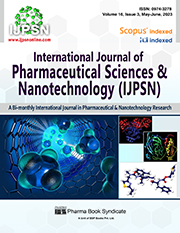In-silico Pharmacology for Evidence-Based and Precision Medicine
DOI:
https://doi.org/10.37285/ijpsn.2023.16.3.1Abstract
Precision medicine, driven by genetic and physical characteristics, has emerged as a transformative approach in healthcare, aiming to provide personalised treatments with optimised efficacy and minimised side effects. This approach contrasts evidence-based medicine, which emphasises population-level data and trends. Technological advancements in pharmacometrics and quantitative systems pharmacology have revolutionised pharmaceutical research, enabling the identification of new drug targets and the development of innovative drug delivery systems. Computational methods, such as quantitative structure-activity relationship (QSAR) analysis and in silico pharmacology tools, have played a pivotal role in identifying potential drugs and repurposing existing ones. These computational approaches leverage diverse data sets and predictive models, leading to significant advancements in optimising drug safety and effectiveness. This transformative era, driven by precision medicine and computational pharmacology, holds immense potential for improving patient outcomes and advancing the field of medicine towards personalised and targeted therapeutic interventions.
Downloads
Metrics
Keywords:
Precision Medicine, Evidence-Based Medicine, In-silico, Pharmacometrics, PharmacokineticsDownloads
Published
How to Cite
Issue
Section
References
Naithani N, Sinha S, Misra P, Vasudevan B, Sahu R. Precision medicine: Concept and tools. Med J Armed Forces India. 2021 Jul;77(3):249–57.
Sackett DL. Evidence-based medicine. Semin Perinatol. 1997 Feb;21(1):3–5.
Leyhe T, Reynolds CF, Melcher T, Linnemann C, Klöppel S, Blennow K, et al. A common challenge in older adults: Classification, overlap, and therapy of depression and dementia. Alzheimer's Dement J Alzheimers Assoc. 2017 Jan;13(1):59–71.
Vázquez-Palacios G, Bonilla-Jaime H, Velázquez-Moctezuma J. Antidepressant-like effects of the acute and chronic administration of nicotine in the rat forced swimming test and its interaction with fluoxetine [correction of flouxetine]. Pharmacol Biochem Behav. 2004 May;78(1):165–9.
Bloomingdale P, Karelina T, Cirit M, Muldoon SF, Baker J, McCarty WJ, et al. Quantitative systems pharmacology in neuroscience: Novel methodologies and technologies. CPT Pharmacomet Syst Pharmacol. 2021 May;10(5):412–9.
Wang YL, Li JY, Shi XX, Wang Z, Hao GF, Yang GF. Web-Based Quantitative Structure-Activity Relationship Resources Facilitate Effective Drug Discovery. Top Curr Chem Cham. 2021 Sep 23;379(6):37.
Ivanov SM, Lagunin AA, Poroikov VV. In silico assessment of adverse drug reactions and associated mechanisms. Drug Discov Today. 2016 Jan;21(1):58–71.
Beckmann JS, Lew D. Reconciling evidence-based medicine and precision medicine in the era of big data: challenges and opportunities. Genome Med. 2016 Dec 19;8(1):134.






